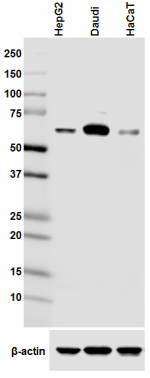- Clone
- 3F8 (See other available formats)
- Regulatory Status
- RUO
- Other Names
- Serine/Threonine protein kinase PLK, Polo-like kinase (PLK), Serine-threonine protein kinase 13
- Isotype
- Mouse IgG1, κ
- Ave. Rating
- Submit a Review
- Product Citations
- publications

-

Total lysates (15 µg protein) from 293T and 293T/PLK-1 CRISPR/Cas9 knockout (KO) cells were resolved by electrophoresis (4-20% Tris-Glycine gel), transferred to nitrocellulose, and probed with 1:500 diluted (1 µg/mL) purified PLK-1 antibody, clone 3F8 (upper). Proteins were visualized by chemiluminescence detection using a 1:3000 diluted goat anti-mouse-IgG secondary antibody conjugated to HRP (Cat. No. 405306). 1:2000 dilution of Direct-Blot™ HRP anti-GAPDH Antibody (Cat. No. 649203) was used as a loading control (lower). Lane M: MW ladder. -

Total lysates (15 µg protein) from HepG2, Daudi and HaCaT were resolved by electrophoresis (4-12% Bis-Tris gel), transferred to nitrocellulose, and probed with 1 µg/ml purified anti-PLK1 antibody, clone 3F8. Proteins were visualized using chemiluminescence detection by incubation with and HRP Goat anti-Mouse secondary antibody (Cat. No. 405306, 1:3000 dilution). Direct-Blot™ HRP anti-β-actin antibody was used as a loading control (Cat. No. 664804, 1:25,000 dilution). -

Whole cell extracts (15 µg protein) from serum starved HeLa untreated (-) or treated (+) with 200 ng/mL of Nocodazole for 20 hours were resolved on a 4-12% Bis-Tris gel and transferred to a PVDF membrane. The membrane was treated (+ LPP) or untreated (- LPP) with lambda protein phosphatase overnight at 4°C and probed with 0.5 µg/mL (1:1000 dilution) of purified anti-PLK-1 Phospho (Thr210) antibody (clone 2A3) for 2 hours at RT. Proteins were visualized by chemiluminescence detection using HRP Goat anti-mouse IgG Antibody (Cat. No. 405306) at a 1:3000 dilution. Direct-Blot™ HRP anti GAPDH Antibody (Cat. No. 607904) was used as a loading control at a 1:25000 dilution (lower). Purified anti-PLK-1 Antibody (Cat. No. 627702) was used as a pan PLK-1 loading control. Lane M: Molecular weight marker.
| Cat # | Size | Price | Quantity Check Availability | Save | ||
|---|---|---|---|---|---|---|
| 627701 | 25 µg | 85€ | ||||
| 627702 | 100 µg | 184€ | ||||
PLK-1 (polo-like kinase 1) is a member of te serine/threonine protein kinase family, cdc5/polo subfamily. Highly homologous to polo-like kinase (Drosophila), PLK-1 contains two polo box domains with a predicted molecular weight of 68 kD. This nuclear protein is highly expressed in placenta and colon and has been shown to regulate cdc2/cyclin B through phosphorylation and activation of cdc25c phosphatase. PLK-1 may also be required for cell division; depletion of PLK-1 results in apoptosis. PLK-1 is upregulated by growth stimulating agents and is regulated by cell cycle position (highest in G2/M phase, declining to nearly undetectable levels after mitosis and throughout G1). PLK-1 is modified by phosphorylation (Thr210 is the major phosphorylation site in activated PLK-1 from mitotic cells) and has been shown to interact with nuclear distribution gene C. The 3F8 monoclonal antibody recognizes human and mouse PLK-1 and has been shown to be useful for Western blotting.
Product DetailsProduct Details
- Verified Reactivity
- Human, Mouse
- Antibody Type
- Monoclonal
- Host Species
- Mouse
- Immunogen
- Amino Acid: 300-603 of human PLK-1
- Formulation
- Phosphate-buffered solution, pH 7.2, containing 0.09% sodium azide.
- Preparation
- The antibody was purified by affinity chromatography.
- Concentration
- 0.5 mg/ml
- Storage & Handling
- The antibody solution should be stored undiluted between 2°C and 8°C.
- Application
-
WB - Quality tested
KO/KD-WB - Verified
IP, ICC - Reported in the literature, not verified in house - Recommended Usage
-
Each lot of this antibody is quality control tested by Western blotting. Western blotting, suggested working dilution(s): Use 1.0 - 5.0 µg (1:100-1:500) antibody per 5 ml antibody dilution buffer for each mini-gel. It is recommended that the reagent be titrated for optimal performance for each application.
- Product Citations
-
- RRID
-
AB_439756 (BioLegend Cat. No. 627701)
AB_439756 (BioLegend Cat. No. 627702)
Antigen Details
- Structure
- Serine/Threonine family of protein kinases, cdc5/polo subfamily. Highly homologous to polo-like kinase (Drosophila). Contains two polo box domains. Predicted molecular weight 68 kD
- Distribution
-
Nuclear protein, highly expressed in placenta and colon
- Function
- Regulates cdc2/cyclin B through phosphorylation and activation of cdc25c phosphatase. May be required for cell division. Depletion of PLK-1 results in apoptosis
- Interaction
- Interacts with nuclear distribution gene C
- Modification
- Phosphorylation
- Biology Area
- Cell Biology, Cell Cycle/DNA Replication, Signal Transduction
- Molecular Family
- Protein Kinases/Phosphatase
- Antigen References
-
1. Hamanaka R, et al. 1994. Cell Growth Differ. 5:249.
2. Lake RJ, et al. 1993. Mol. Cell. Biol. 13:7793.
3. Holtrich U, et al. 1994. P. Natl. Acad. Sci. USA 91:1736. - Regulation
- Upregulated by growth stimulating agents. Regulated by cell cycle position (highest in G2/M phase and declines to nearly undetectable levels after mitosis and throughout G1)
- Gene ID
- 5347 View all products for this Gene ID
- UniProt
- View information about PLK-1 on UniProt.org
Related Pages & Pathways
Pages
Related FAQs
Other Formats
View All PLK-1 Reagents Request Custom Conjugation| Description | Clone | Applications |
|---|---|---|
| Purified anti-PLK-1 | 3F8 | WB,KO/KD-WB,IP,ICC |
Compare Data Across All Formats
This data display is provided for general comparisons between formats.
Your actual data may vary due to variations in samples, target cells, instruments and their settings, staining conditions, and other factors.
If you need assistance with selecting the best format contact our expert technical support team.

 Login / Register
Login / Register 










Follow Us